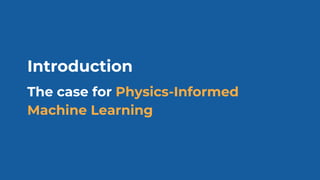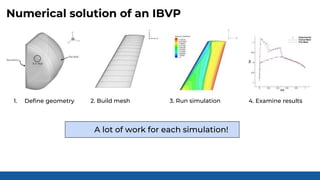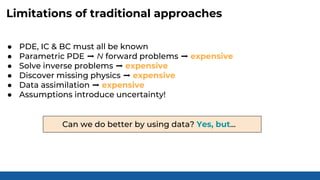Physics-Informed Machine Learning
- 1. GDSC, University of Bologna, November 15 2021 A short intro to Physics- informed Machine Learning Andrea Panizza
- 2. Introduction The case for Physics-Informed Machine Learning
- 3. Physics, PDEs and IBVP Flow around a landing gear (NASA Ames) Simulations of micro-fluidics at cell resolution (ETH Zurich) Flow field in a simulated wind-farm (JHU) pics from https://events.seas.upenn.edu/event/meam- seminar-bridging-physical-models-and-observational- data-with-physics-informed-deep-learning/
- 4. Numerical solution of an IBVP 1. Define geometry 2. Build mesh 3. Run simulation 4. Examine results A lot of work for each simulation!
- 5. Limitations of traditional approaches ● PDE, IC & BC must all be known ● Parametric PDE ➡︎ N forward problems ➡︎ expensive ● Solve inverse problems ➡︎ expensive ● Discover missing physics ➡︎ expensive ● Data assimilation ➡︎ expensive ● Assumptions introduce uncertainty! Can we do better by using data? Yes, but...
- 6. Machine Learning Great at data assimilation…. ...and high-dimensional optimization... ...but! Data-hungry And each simulation is expensive
- 7. Limitations of Machine Learning ● Data generation is expensive ● Solutions don’t necessarily respect symmetries/conservation laws ● Physicists look for “universal” laws, but Deep Learning struggles with Out-Of-Distribution generalization Enter Physics-Informed Machine Learning
- 8. How to embed physics in ML
- 13. https://arxiv.org/abs/2012.07938 Complex geometries Flow around a heat sink Flow inside an aneurysm
- 14. Different physical laws Acoustics... Maxwell equations...
- 15. Issues with PINNs (1/2) Convergence pathologies... exact solution PINN solution exact solution PINN solution exact solution PINN solution https://arxiv.org/abs/2012.10047 https://arxiv.org/abs/2109.01050
- 16. Issues with PINNs (2/2) ...which can be fixed! Beware of vanilla PINNS exact solution PINN solution exact solution PINN solution exact solution PINN solution https://arxiv.org/abs/2012.10047 https://arxiv.org/abs/2109.01050
- 17. Conclusions
- 18. Key takeaways ● Embed Physics into ML ● Many different approaches ● Some great results… ● ...but many open problems!
- 19. What we didn’t cover ● Differentiable physics ● Learning Symbolic Physics with Graph Networks ● Hybrid approaches
- 20. Thanks for listening! https://www.linkedin.com/in/andrea-panizza- 7114025/ https://github.com/AndreaPi https://twitter.com/unsorsodicorda Andrea Panizza Senior AI Specialist *special thanks to Simone Scardapane for the slides layout



















